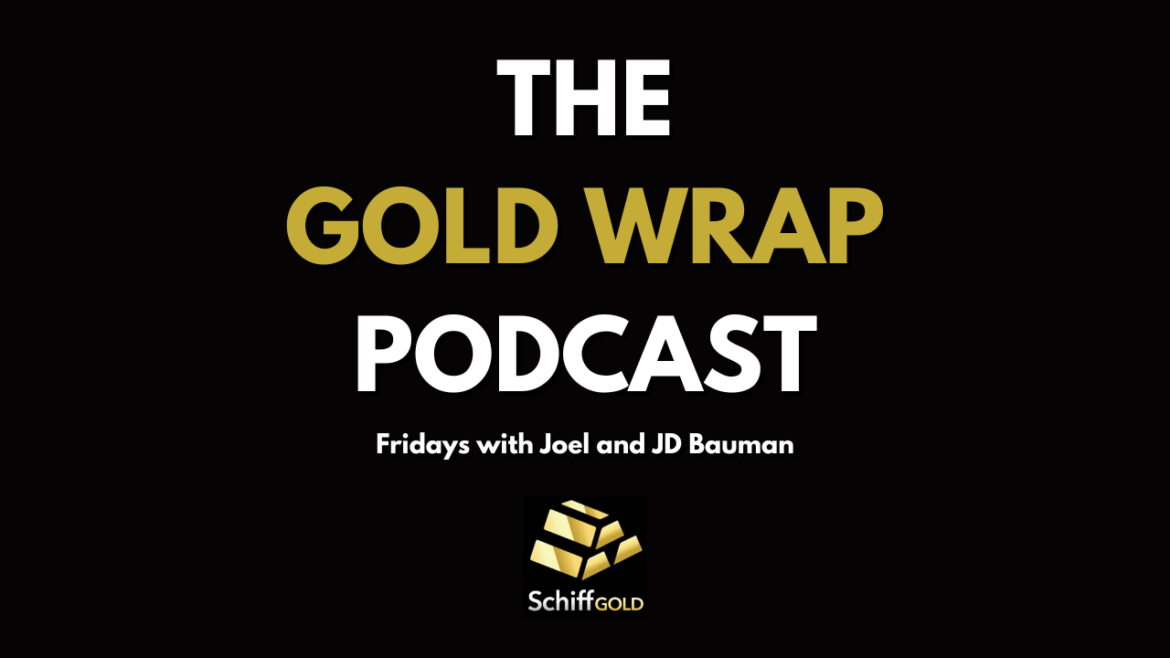Precious metals are apparently waking up. And here is where you can find the best deals.
Site:
Precious metals news
 Gold's Winning Streak Interrupted, Prices Dip Near $2,050 Amid Strengthening Dollar
Gold's Winning Streak Interrupted, Prices Dip Near $2,050 Amid Strengthening DollarJan 16, 2024 - 06:41:44 PST
Gold prices have taken a slight downturn, halting a three-day winning streak, and are currently trading around $2,050 per troy ounce. This decline is attributed to the strengthening U.S. Dollar, which gained momentum following positive US Treasury yields and hawkish comments from Atlanta Fed President Raphael Bostic. Despite this setback, there is potential for increased gold demand due to rising risk aversion linked to escalating conflicts in the Middle East.
 Dollar Nears Monthly Peak Amid Rising US Yields and Anticipation of Rate Cuts
Dollar Nears Monthly Peak Amid Rising US Yields and Anticipation of Rate CutsJan 16, 2024 - 06:28:11 PST
The U.S. dollar is approaching its highest level since December, driven by an increase in Treasury yields and investor speculation about upcoming U.S. interest rate reductions. The Bloomberg Dollar Spot Index saw a rise of 0.3%, potentially reaching its peak since mid-December. This surge comes as investors eagerly await insights from Federal Reserve Governor Christopher Waller, following Chair Jerome Powell's indication of possible rate cuts in 2024. The rise in Treasury yields across various maturities after a U.S. holiday also contributed to the dollar's strength. Currency trader Mingze Wu from Stonex Financial suggests that the market is realigning its expectations, possibly doubting any rate cuts by Powell within the year.
When a country starts to develop economically, a few things tend to happen: the death rate falls, workers become more productive, consumers consume more, and birth rates normally fall. During this period, countries experiencing such changes have a relatively small number of retirees and a small share of the population composed of children.
 BARRICK GOLD GETS A STOCK ENEMA TODAY: Gold Production Falls To Two-Decade Low As Company Under-Reports Total Costs
BARRICK GOLD GETS A STOCK ENEMA TODAY: Gold Production Falls To Two-Decade Low As Company Under-Reports Total CostsJanuary 16, 2024
After the company reported lower-than-expected gold production today, Barrick's share price plummeted nearly 10%. Barrick's gold mine supply is now the lowest in over two decades. How could this be when the company invested billions in the past decade to expand production...
The U.S. Bureau of Labor Statistics (BLS) recently released two inflation reports highlighting inflation figures for December 2023. Here's what they showed:
In a disturbing (but unsurprising) trend, more than 1 out of 4 US consumers are throwing in the towel with defeatist “Doom Spending” sprees — despite already being saddled with crippling levels of debt. This behavior is akin to someone who, feeling overwhelmed, indulges excessively in a habit they know isn't beneficial. In a similar vein, these Americans, perhaps feeling a sense of despair, are accumulating unprecedented levels of new debt through spending sprees that are beyond their financial means.
The first half of 2023 was a record-breaking moment for central bank gold buying, led by none other than China and Russia. Organizations like the World Gold Council reported a staggering increase compared to 2022:
 ENERGY MARKET UPDATE JAN 13th: Volatile Natgas Prices, But Remain At Yearly Lows & Oil Prices May Remain Weak Into 2024
ENERGY MARKET UPDATE JAN 13th: Volatile Natgas Prices, But Remain At Yearly Lows & Oil Prices May Remain Weak Into 2024January 13, 2024
While Natgas prices were extremely volatile last week, they continue to remain at yearly lows. So, what's next for the Energy Market heading into 2024? With petroleum demand beginning to weaken in the United States, it could set up for lower prices in the next few quarters...
In this week's Friday Gold Wrap Podcast, JD and Joel discuss recent gold price action and market news. They also cover last Friday's non-farm payroll numbers, the strike on Houthi rebels, and the SEC's fumble with Bitcoin ETFs.
On Wednesday, January 11, the Securities and Exchange Commission (SEC) made an interesting decision, voting to allow everyday folks to participate in spot bitcoin ETFs. This move marks an opening for a broader audience to delve into Bitcoin speculation. The approved ETFs are set to be listed on various exchanges, including Nasdaq, the New York Stock Exchange, and the Chicago Board Options Exchange. This is supposed to provide an additional layer of oversight. But the announcement went terribly wrong, amplifying concerns about the ETFs.
In December, the U.S. federal deficit soared to $129 billion, marking a dramatic 52% increase from the previous year. This rise was fueled by a 3% hike in government expenditures, reaching a record $559 billion, primarily driven by escalated Social Security and public debt interest costs. Compounding the situation, December saw a 6% drop in government receipts to $429 billion, contrasted against the higher levels of December 2022, inflated by pandemic-delayed tax payments. Notably, the first quarter of the 2024 fiscal year witnessed the deficit climbing to $510 billion, a 21% rise from last year, with both outlays and receipts hitting record highs. The cost of interest on public debt also surged by 11% to $119 billion in December, attributed to elevated debt levels and a higher average interest rate of 3.11%, significantly up from the previous year.
Argentina’s inflation rate as hit annual rate of 3,678%. What can be done when the public loses faith in a currency?
The U.S. Labor Department reported a higher-than-anticipated rise in consumer prices for December, indicating persistent inflationary pressures in the economy. The consumer price index (CPI) saw a 0.3% increase in December, surpassing the 0.2% estimate expected by many economists and policymakers. This rise pushed the annual CPI rate for 2023 to 3.4%, exceeding the Dow Jones surveyed economists' forecast of 3.2%. This figure represents a notable decrease from the 6.4% annual CPI gain recorded in December 2022, yet suggests that inflation remains a concern.
A US government operation led by the Secret Service from 1865 covertly dismantled the gold and silver currency system.This strategic move, propelled by two acts of Congress, was a cunning ploy that centralized economic power.A commentator from the Mises Institute explores the little-known involvement of the Secret Service in this historical development, and how it impacted the very concept of US currency.
In a landmark decision, the U.S. Securities and Exchange Commission (SEC) has approved applications for spot price Bitcoin exchange-traded funds (ETFs) from 11 issuers, signaling a new era for cryptocurrency. Among the approved are applications from major financial players like BlackRock, Fidelity, and Franklin Templeton. Additionally, the SEC has authorized the digital asset manager Grayscale to convert its Bitcoin trust into a spot Bitcoin ETF. This approval is particularly significant for Grayscale, with a spokesperson confirming their readiness to uplist GBTC to NYSE Arca. Fidelity is also finalizing the registration process for its Bitcoin ETF, working in close coordination with the SEC. This decision by the SEC has been eagerly awaited and is seen as a major boost to the cryptocurrency market.
Jan 11, 2024 - 05:28:18 PST
Despite a rocky start for U.S. stocks in 2024 and a general bearish sentiment among Wall Street analysts, James Demmert, Chief Investment Officer at Main Street Research, offers a strikingly optimistic forecast. Demmert, overseeing a firm with $2 billion in assets, predicts a significant bull run for U.S. stocks in the next decade, fueled by the burgeoning artificial intelligence technology sector. He anticipates major U.S. equity indexes, including the S&P 500, Dow, and Nasdaq Composite, could double or even triple their value. "Similar to the 1990s, we are experiencing a transformational change in technology that is going to have far-reaching impact," the chief investment officer says...
 BEST & WORST PERFORMING SILVER MINERS: The Breakdown Of Gold & Silver Revenue Per Company & Trade Alert
BEST & WORST PERFORMING SILVER MINERS: The Breakdown Of Gold & Silver Revenue Per Company & Trade AlertJanuary 11, 2024
While investor sentiment in the mining shares has sunk to a LOW, one company has outperformed its competitors. What company am I talking about, and the group's worst-performing silver miner may be setting up for a short-term opportunity? Which one is it...
As 2024 unfolds, the financial markets face a new reality: the era of ultra-low, zero-percent interest rates is likely over. Investors, who initially believed the economy was deteriorating, adjusted their expectations towards the end of 2023, recognizing signs of improving economic conditions and a potential decrease in both inflation and interest rates. However, recent developments suggest that interest rates may not decline as significantly as hoped, given the stronger-than-expected economic performance. This change in perspective is causing some concern among investors.
Japan, once a dominant force in global gold importing during the 1980s and 1990s, has undergone a significant shift in its gold market dynamics. This change was initially influenced by the introduction of a consumption tax and further accelerated after the collapse of Japan's economic bubble in the 2000s. The country, which used to import gold extensively from various international sources, has now become a net exporter, primarily to Asia and London. This shift is exemplified by the author's experience at a Tokyo bank branch, where gold was mostly exported during their tenure. The evolving consumption tax, rising from 3% in 1989 to 10% in 2019, plays a complex role in this transformation. Although the tax is refunded upon selling gold, theoretically not impacting gold investment negatively, it has indirectly contributed to Japan's transition from a major gold importer to a net exporter.
Jan 10, 2024 - 08:56:03 PST
Morgan Stanley's recent analysis highlights a significant shift in how gold prices react to US interest rates and bond yields. Traditionally, gold prices have been influenced by the US dollar and inflation-adjusted bond yields, but this relationship notably weakened in the latter half of last year. Despite the decrease in US real yields, gold didn't gain as much as expected, partly due to escalating geopolitical tensions. Morgan Stanley analysts observed that gold's connection with real yields has evolved, displaying reduced sensitivity to yields while increasingly being perceived as a safe haven asset.












